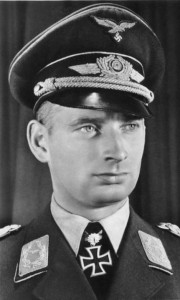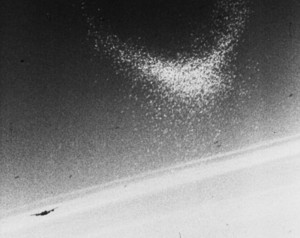
Published on July 3, 2012
On this day in aviation history in 1943, the German Luftwaffe introduced a new tactic called “Wilde Sau” (Wild Boar) to counter the Royal Air Force’s night bombing offensive. The idea of pilot Hajo Herrmann, the Luftwaffe would fly its daytime defense fighter aircraft, mainly single seat Fw-190s and Me-109s, and seek out the British bombers by diving from above after spotting them silhouetted against the lights of cities.
The tactic was directly backwards from the usual method of defense when cities were to be “blacked out” during the nights in hopes that the RAF bombs would miss their targets. With the Wild Sau tactics, it was shown that the bombers could be most effectively spotted and attacked on nights when the skies were overcast and the bombers were coming in above the clouds. The British planes would stand out against the background lights and could be easily attacked from above, while the German planes would come out of the darkness, shooting without warning.
Prior to the introduction of Wilde Sau tactics, the Luftwaffe’s night fighter methodology had relied exclusively on specially configured night fighter aircraft fitted with radar systems. The aircraft would orbit at designated points spread across the German countryside and, once targets were identified, they would be assigned headings and altitudes to fly by their ground radar controllers. Once near enough to the bomber, the fighter’s own short range radar would allow the pilot to fly in close and see the fires of the bomber’s engine exhausts or pick out the RAF bomber against the stars. The German night fighter then would use its guns to shoot the bomber down. The problem was that there were never enough specially fitted night fighters or ground controllers — and the British were coming in ever increasing numbers.
Thus, on July 3, 1943, Hajo Herrmann’s Wilde Sau tactics would be introduced. That night, the British bombers targeted the city of Cologne. At first, the glow of the city below was a welcome aid to the British in their bombing runs, but then, the first of Hajo Herrmann’s Wilde Sau fighters dove into the bomber stream from above. They claimed twelve bombers shot down that night, although the ground-based anti-aircraft guns shooting blindly into the night skies also claimed the same planes. Officials decided to allow the two forces to take credit for half each, but for the fighter pilots, they knew what they had achieved. The time of the Wilde Sau had come — and soon the Luftwaffe organized the Wilde Sau forces into a dedicated squadron, Jagdgeschwader 300.
The Wilde Sau attacks were continuously improved as experience mounted. This once radical idea became one of the key defensive tactics against British night bombing. The Wilde Sau tactics would reach their peak effectiveness during the Berlin bombing campaign on the night of August 22, 1943. The Wilde Sau pilots would claim 57 RAF bombers shot down.

For the RAF, the Wilde Sau tactics would result in many more aircraft and crews lost. Nonetheless, the RAF intensified its efforts. Just a few weeks after the introduction of the Wilde Sau tactics, the RAF would introduce an impressive innovation called “Window.” It was low tech but highly effective, involving nothing more than throwing out small bundles of thinly cut strips of aluminum foil regularly while flying to and from the target. The “Window” foil strips were cut to the specific length to reflect the German radar frequencies. This left German radar operators with screens that showed an indistinct mass of white lines instead of clear indicators for each enemy aircraft flying through their zone. Without radar guidance, the regular night fighter forces were left flying randomly around in hopes of chancing across a bomber.
Using “Window,” the RAF would undertake one of the most devastating bombing campaigns of the war — Operation Gomorrah, the fire bombing of the city of Hamburg. In a single week of bombing, 42,600 were killed, 37,000 wounded, and 250,000 were made homeless. Fully 1 million would flee the city carrying stories about the firestorm that had resulted, when the incendiary bombs ignited massive fires that turned into 1,000 foot high flaming tornadoes with winds of 150 mph. It was terrifying and the bodies of many victims were incinerated to ash as temperatures reached over 1,500 degrees Fahrenheit (800° C). Despite the horrific damage done, it wasn’t the bombing campaigns that defeated Germany. The bombing campaigns stripped the German army of supplies and fuel — but it was still the job of the ground forces to finish the war.
One More Bit of Aviation Trivia
During World War II, the RAF countered the Luftwaffe’s night fighters with women in the WAAFs who were fluent in the German language. German radar controllers too were almost exclusively women, as their voices could be better heard over the radio jamming. The RAF program code-named Corona employed specially trained women who would broadcast false heading and altitude instructions to German night fighter crews. German pilots were thus confused by conflicting orders being received while German and British controllers argued over the radio, trying to discredit each other. British bombers also carried a system called “Tinsel”, which involved microphones in the engine cowlings to broadcast engine noise onto the night fighters’ frequencies. Combined, this reduced radio to chaos. The Germans always thought that the RAF’s women were flying over Germany. They did their best to shoot one down. They were never successful because actually, the British women were sitting in secret communications bunkers in southern England, using very high powered transmitters — not a single one was ever killed or captured throughout the war.
